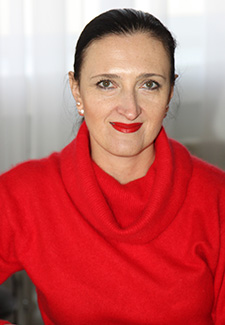Scientific profile

Associate Professor, Candidate of Technical Sciences (Ph. D.)
Olena
NESTEROVA
Contacts and CV
Research
Current research
«Improving the efficiency of systems and facilities for water supply, disposal and small water bodies» No. 0121U100400 (2021-2023) – «Improving methods for calculating river flow regulation», «Approaches to determining water losses from reservoirs and assessing its effect on the environment».
More
Past research
«Research of the operation of systems and structures of water supply and disposal, improvement of methods for calculating the elements, bases and foundations of hydraulic structures» No. 0116U000779 (2016-2020) – «Improvement of methods for static calculation of systems base-foundation-super-foundation building and water supply facilities».
More
Publications
1. Нестерова О. В. Проблеми басейнів малих річок / О. В. Нестерова, В. В. Шарков, О. А. Журавлева, Я. С. Нестеров // Вісник Придніпровської державної академії будівництва та архітектури. Дніпро: ПДАБА. 2019. Вип. 5. С. 67 – 75. https://doi.org/10.30838/J.BPSACEA.2312.221019.68.524
2. Nechytailo М., Nahorna O., Nesterova The grounds for the modification of membranes with the help of quantum mechanical calculation method / E3S Web of Conferences: II International Conference Essays of Mining Science and Practice. 168, 00032 (2020) 06 May 2020, 11 p. DOI:
https://doi.org/10.1051/e3sconf/202016800032 (Indexed in Scopus)
3. Шаповал В. Г., Скобенко О. В., Нестерова О.В., Гапєєв С. М. Розподіл вертикальних напруг в основі грунтової греблі із трапецеїдальним поперечним перетином / Український журнал будівництва та архітектури. Дніпро: ПДАБА. 2021. Вип. 2. С.131-138. https://doi.org/10.30838/J.BPSACEA.2312.270421.131.760
4. Шарков В.В., Нестерова О.В., Журавльова О.А., Жефруа Д.В. Пошук точок приєднання додаткових джерел живлення систем водопостачання / Український журнал будівництва та архітектури. Дніпро: ПДАБА, 2021. Вип. 3. С.116-123. https://doi.org/10.30838/J.BPSACEA.2312.010721.116.774
5. Шаповал В.Г., Іванова Г.П., Терещук Р.М., Нестерова О.В. Осідання дорожного полотна на складених зі слабких ґрунтів основах / Наука та прогрес транспорту. 2021. 2(92). С. 92–98. https://doi.org/10.15802/stp2021/236306
Courses
1. Hydrology and hydrometry
To form students' competencies in the field of basic laws and processes occurring in water bodies that are sources of water supply for engineering networks, as well as methods and technical means for measuring and determining the main hydrological characteristics of watercourses and reservoirs during the operation of hydraulic structures; theoretical foundations and methods of engineering hydrological and water management calculations; to teach the application of these methods in the design and operation of hydraulic, water management and agricultural systems, as well as the formation of a hydrographic network and river systems; on methods of hydrological observations and calculations for determining the parameters of hydraulic structures. Hydrology and hydrometry are elective disciplines in the preparation of bachelors working in the field of construction and operation of engineering networks that provide water supply and disposal for residential and civil facilities.
2. Means to control the technological processes of water supply and water disposal
The discipline explores ways to ensure interchangeability at the stages of the product life cycle; methods for normalizing the accuracy of parameters; basic principles for building tolerance and landing systems; basic standards of basic interchangeability standards covering systems of tolerances and fits for typical types of connections; theoretical bases of measuring control of parameters; theoretical aspects of the scientific approach to the quality management of products, works and services; the structure of international and national quality standards; functions of quality management at the enterprise and the main methodological approaches to their implementation; methodology for assessing the level of quality; procedure and certification rules.
3. Hydrotechnical structures
The purpose of the discipline is to acquire by students the competencies necessary for the implementation of innovative, surveying and design and calculation activities to ensure the safety of hydraulic structures, the development and implementation of measures to prevent and eliminate the consequences of accidents in GTS.
Possession of the theory and methods of hydraulic engineering, as well as related branches of science, which makes it possible to design hydraulic structures and explore the processes occurring in hydraulic structures and the processes of interaction of hydraulic structures with the natural environment, improve the design of hydraulic structures.
4. Scientific research in the field of water supply and water disposal
The discipline must teach the methodology of the systemic solution of complex problems in the construction and operation of water supply and drainage systems, in solving problems of technological modeling and performing research work. How to use a system of methodological principles and approaches to scientific research and systematic problem solving in the field of water supply and disposal.
5. Systems of water supply and water disposal in settlements
The development of modern settlements would be impossible without water supply and disposal systems. The solution to the problem of providing the population with drinking water of guaranteed quality is possible through the introduction of modern technologies, facilities, reagents, materials and equipment, as well as the restoration of drinking water distribution systems. The main task of the operation of drainage systems is the prevention and elimination of violations of the system.
6. Modern devices for experimental research
At the current stage of development of water treatment technology, it is impossible to manage water supply and drainage systems without using modern devices. Knowledge is required of not only technology and equipment, but also of automatic monitoring and control devices - from the simplest devices to microcontrollers and computer control systems. Modern water supply and sanitation systems, which are a complex set of dispersed structures connected by a single technological cycle, are designed and built with centralized control based on the automation of individual processors and the use of computer technology and telemechanics for control and monitoring the usage of modern devices.
